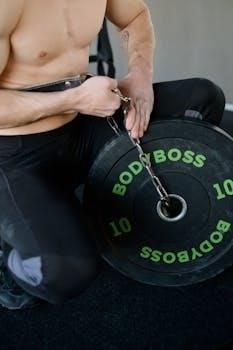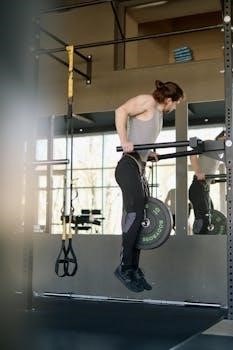
Weight training is crucial for sprinters, building skeletal muscle to increase strength and power. This type of training helps sprinters develop the necessary force to propel themselves off the blocks and move limbs quickly, maximizing speed potential. Incorporating a structured weight training program, alongside track work, is essential for optimal performance.
Importance of Strength Training for Sprinters
Strength training is paramount for sprinters, it is not just about building muscle mass, it’s about enhancing the explosive power crucial for sprinting performance. Lifting weights increases the force your muscles can generate, allowing for more powerful strides and quicker acceleration. This type of training helps sprinters propel themselves off the blocks with more force, leading to faster times. Additionally, strength training supports overall stability and reduces the risk of injuries. A well-designed program will target key muscle groups used in sprinting, improving both speed and efficiency. It is vital for sprinters to incorporate strength training into their routine, as it is a major component of becoming a well-rounded athlete. Strength training for sprinters should focus on producing power and force, which are essential elements for success on the track.

Key Muscle Groups for Sprinters
Sprinter weight training focuses on building strength, power, and endurance in key muscles. These include the quadriceps, hamstrings, glutes, calves, and core muscles. These muscle groups are crucial for speed, power and stability.
Quadriceps, Hamstrings, and Glutes
The quadriceps, hamstrings, and glutes are fundamental for sprinting, working together to produce the explosive force needed for acceleration and top speed. Weight training exercises targeting these muscles are essential for enhancing a sprinter’s performance. The quadriceps, located at the front of the thigh, are responsible for extending the knee, a key action in pushing off the ground. Strengthening these muscles through exercises like squats and lunges can significantly improve a sprinter’s power. The hamstrings, located at the back of the thigh, are vital for knee flexion and hip extension, ensuring smooth and powerful leg movements. Exercises such as deadlifts and single-leg deadlifts can strengthen the hamstrings. The glutes, located in the buttocks, play a crucial role in hip extension and stabilization. Exercises like hip thrusts and glute bridges can enhance the glutes’ contribution to a powerful stride. By focusing on these muscle groups, sprinters can create a more powerful and efficient running form.
Core Muscle Strengthening
Core strength is paramount for sprinters, providing the stability necessary to transfer power from the legs to the upper body. A strong core prevents swaying and allows for more efficient energy transfer during each stride. Exercises that target the core muscles, including the abdominals, obliques, and lower back, are crucial for a sprinter’s training regime. Planks, a fundamental core exercise, help to develop isometric strength, which is vital for maintaining a stable torso during high-speed movements. Medicine ball routines and staggered stance kettlebell swings help build dynamic core strength, improving the ability to control rotational forces. Strengthening the core also helps in injury prevention by providing better spinal alignment and reducing stress on the lower back. By incorporating a variety of core exercises, sprinters can improve their running efficiency and overall performance. A strong core also enables better coordination between the upper and lower body, crucial for generating explosive speed.

Weight Training Exercises for Sprinters
Sprinter weight training includes exercises that build strength, power, and endurance in key muscles. These exercises use free weights, machines, and resistance bands to target the quadriceps, hamstrings, glutes, calves, and core muscles.
Lower Body Focus⁚ Squats, Lunges, and Deadlifts
For sprinters, a strong lower body is paramount, making exercises like squats, lunges, and deadlifts crucial components of a training regimen. Back squats, performed with an emphasis on explosive upward movement and full depth, are highly effective for developing power in the legs. Lunges, executed with a full range of motion and controlled pace, help build strength and stability in each leg individually. Single-leg deadlifts further enhance balance and hamstring strength, vital for efficient sprinting mechanics. These movements improve overall lower body power and force production, which is essential for accelerating and maintaining top speed. Variations, like quarter squats with weights, can be included for advanced athletes to focus on starting strength. Incorporating these exercises with proper form and technique will significantly improve a sprinter’s performance on the track. Utilizing these with a focus on explosive movement and the appropriate cadence will maximize the benefits.
Upper Body Strength⁚ Bench Press Variations
While lower body strength is vital for sprinting, upper body strength plays a crucial role in maintaining balance, generating power, and coordinating movements. Bench press variations, such as the alternating dumbbell bench press, can be an effective way for sprinters to enhance upper body strength. This exercise not only builds muscular strength but also allows for creativity and flashy movements which are helpful. It’s important to focus on proper form and controlled movements to maximize the benefits of the exercise. Furthermore, other upper body exercises, like dumbbell floor presses, can be included to build all-around upper body strength. These variations improve the ability to effectively use the upper body with the trunk and coordinate with the legs during sprinting. A well-developed upper body will contribute to overall balance and power output, improving performance.
Explosive Movements and Plyometrics
To truly maximize sprinting performance, incorporating explosive movements and plyometrics is essential. These exercises focus on developing power, which is the ability to apply force rapidly. Plyometrics, such as box jumps and medicine ball routines, help improve the nervous system’s ability to activate muscles quickly, leading to faster and more powerful movements. For example, a sprinter could perform box jumps, focusing on quick, explosive movements. Another option is pushing a heavy sled for a short distance and then immediately performing an explosive movement like a jump. This complex training approach helps in increasing muscle force and performance. These types of exercises are crucial for sprinters to improve their ability to explode off the blocks and generate force with each stride. Reactive strength can also be introduced later in the season, closer to competition, and it crosses over with explosive training.
Sample Weekly Training Program
A sample weekly program should integrate strength and sprint workouts. It needs to balance gym sessions with track work to optimize a sprinter’s performance. This ensures development of both strength and speed, for optimal results.
Combining Strength and Sprint Workouts
Integrating strength training and sprint workouts is essential for sprinters, as it allows for a holistic approach to performance enhancement. Strength training builds the necessary muscle and power, while sprint workouts refine speed and technique. A balanced program should alternate between these two types of training, ensuring that neither is neglected. For example, a week might include two or three strength sessions focusing on lower body power, followed by track sessions that emphasize speed and acceleration. This combination is important because strength developed in the weight room directly translates to faster and more powerful sprints on the track. To avoid interference, it is important to strategically place these workouts. For example, heavy lifting and track work should ideally not be done on the same day. This approach ensures muscle recovery, reduces injury risks, and maximizes the benefits of both strength and sprint training. A well-structured program allows for a synergy where both elements work together to boost overall sprinting performance.

Advanced Training Techniques
Advanced training involves complex training, combining heavy lifting and plyometrics to activate the nervous system and increase muscle force. These methods enhance power production through explosive movements under heavy loads, essential for maximizing sprinting performance.
Complex Training and Heavy Lifting
Complex training integrates heavy resistance exercises with plyometric movements to enhance power output. This method involves performing a strength-based lift, such as a heavy squat or deadlift, immediately followed by an explosive exercise, like a box jump or a medicine ball throw. The heavy lift primes the nervous system, allowing for greater force production during the subsequent plyometric movement. This combination helps sprinters improve their ability to apply force rapidly, a crucial element in sprinting performance; Furthermore, heavy lifting, using loads that are close to an athlete’s maximum, is essential for building the underlying muscular strength that is required to generate power. This phase often incorporates exercises like squats, deadlifts, and bench presses, focusing on proper form and controlled movements, to maximize strength gains. The aim is to develop both the neural drive and muscular strength to create explosive movements during the sprint.

Additional Resources
Apps like Peak Strength offer customized weight training programs for sprinters. These resources provide valuable guidance, helping athletes track progress and optimize their training routines, ensuring they are well-prepared for competition and are always improving.
Using Apps for Sprinter Training
Several mobile applications are available today which help sprinters structure their weight training routines. These apps, such as Peak Strength, provide pre-designed programs tailored to the specific needs of sprinters, offering a convenient way to track progress and ensure consistency. These applications often include video demonstrations of exercises, ensuring correct form and reducing the risk of injury. Furthermore, some apps allow for customization, adapting the training plan to individual athlete requirements and goals. The ability to log workouts, monitor performance metrics, and receive personalized feedback are additional benefits of utilizing these technological resources. These apps can be particularly useful for sprinters who are looking for structure and guidance without the need for a personal coach. It is important to choose an app that aligns with the athlete’s level of experience and training goals, ensuring the program is both challenging and safe. Utilizing technology like this can greatly enhance a sprinter’s ability to track progress and maintain consistency in their weight training efforts, contributing to improved performance.